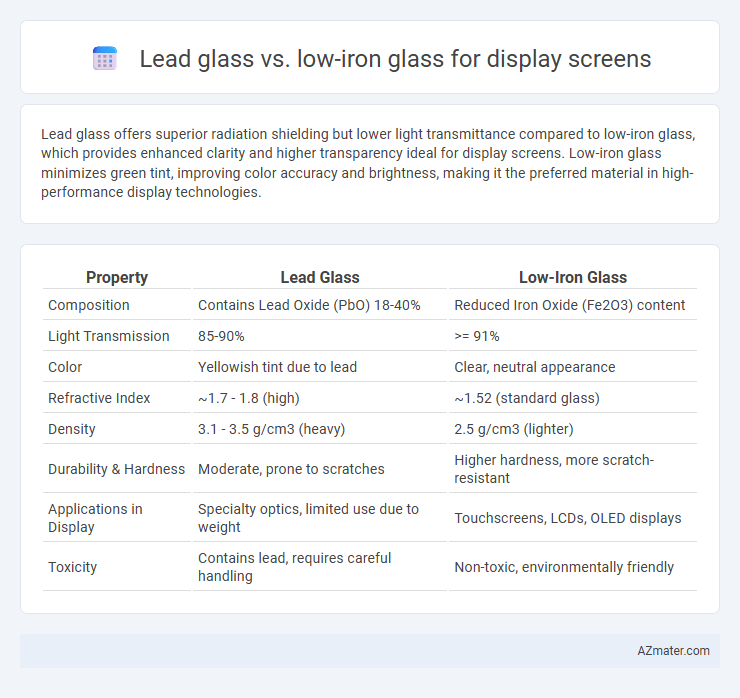Lead glass offers superior radiation shielding but lower light transmittance compared to low-iron glass, which provides enhanced clarity and higher transparency ideal for display screens. Low-iron glass minimizes green tint, improving color accuracy and brightness, making it the preferred material in high-performance display technologies.
Table of Comparison
| Property | Lead Glass | Low-Iron Glass |
|---|---|---|
| Composition | Contains Lead Oxide (PbO) 18-40% | Reduced Iron Oxide (Fe2O3) content |
| Light Transmission | 85-90% | >= 91% |
| Color | Yellowish tint due to lead | Clear, neutral appearance |
| Refractive Index | ~1.7 - 1.8 (high) | ~1.52 (standard glass) |
| Density | 3.1 - 3.5 g/cm3 (heavy) | 2.5 g/cm3 (lighter) |
| Durability & Hardness | Moderate, prone to scratches | Higher hardness, more scratch-resistant |
| Applications in Display | Specialty optics, limited use due to weight | Touchscreens, LCDs, OLED displays |
| Toxicity | Contains lead, requires careful handling | Non-toxic, environmentally friendly |
Introduction to Display Screen Glass Types
Lead glass offers high density and excellent radiation shielding properties, commonly used in specialized display screens requiring protection from X-rays or other radiation. Low-iron glass provides enhanced clarity and minimal green tint, making it ideal for high-definition display screens where true color representation and maximum light transmission are crucial. Both types serve distinct purposes in display technology, balancing optical performance and functional requirements.
Overview of Lead Glass
Lead glass, known for its high refractive index and exceptional clarity, enhances display screen brightness and color accuracy by reducing light dispersion and glare. Its dense composition offers superior radiation shielding, making it ideal for screens in medical and scientific imaging applications. Despite its optical benefits, the increased weight and cost compared to low-iron glass limit its use primarily to specialized high-performance displays.
Overview of Low-Iron Glass
Low-iron glass is characterized by its reduced iron oxide content, typically less than 0.03%, resulting in higher clarity and improved light transmission compared to standard lead glass. This enhanced transparency makes low-iron glass ideal for display screens, where color accuracy and brightness are critical for visual performance. Its minimal green tint and superior optical purity contribute to sharper, more vibrant images, setting it apart as the preferred material in high-end electronic displays.
Key Properties Comparison
Lead glass offers high density and excellent radiation shielding, making it suitable for specialized display screens requiring protection from X-rays or gamma rays. Low-iron glass provides superior optical clarity and minimal green tint, enhancing color accuracy and brightness in standard display applications. Both materials exhibit different refractive indices and transmission properties, with low-iron glass optimizing visual performance and lead glass prioritizing protective functionality.
Optical Clarity and Light Transmission
Lead glass offers enhanced optical clarity due to its high refractive index, which reduces light scatter and improves contrast for display screens. Low-iron glass provides superior light transmission by minimizing iron oxide content, resulting in higher visible light passage and more vibrant color accuracy. Choosing between the two depends on whether the priority is sharper image quality with lead glass or maximum brightness and color fidelity with low-iron glass.
Durability and Strength
Lead glass offers superior strength and chemical durability due to its high lead oxide content, making it more resistant to impact and scratches compared to low-iron glass. Low-iron glass provides enhanced optical clarity and color accuracy but typically compromises some mechanical strength and is more prone to surface damage under stress. For display screens requiring robust durability and resistance, lead glass is generally the preferred material.
Environmental and Health Considerations
Lead glass, commonly used in display screens for its radiation shielding properties, poses environmental and health risks due to lead toxicity and potential contamination during manufacturing and disposal. Low-iron glass offers an eco-friendly alternative by reducing harmful metal content, thus minimizing toxic waste and improving recyclability without compromising clarity and durability in display applications. Choosing low-iron glass supports sustainable production practices and reduces hazards associated with lead exposure for both workers and end-users.
Cost and Availability
Lead glass offers high clarity and excellent shielding properties but tends to be more expensive and less readily available compared to low-iron glass. Low-iron glass is widely accessible, cost-effective, and provides superior purity and light transmission, making it a preferred choice for display screens. Manufacturers favor low-iron glass due to its balance of affordability and optimal optical performance in electronic displays.
Applications in Display Technology
Lead glass is favored in specialized display technologies for its high density and excellent radiation shielding, making it ideal for medical and scientific imaging screens. Low-iron glass offers superior clarity and light transmittance, essential for high-definition displays, touchscreens, and OLED panels where color accuracy and brightness are critical. Both materials enhance display performance in distinct ways, with low-iron glass dominating consumer electronics due to its minimal impurities and enhanced optical properties.
Conclusion: Choosing the Right Glass for Display Screens
Lead glass offers superior radiation shielding and enhanced clarity due to its high refractive index, making it suitable for specialized display screens requiring protection from X-rays. Low-iron glass provides higher transparency and true color rendition by minimizing iron content, ideal for high-definition displays and devices emphasizing visual accuracy. Selecting between lead glass and low-iron glass depends on whether radiation protection or optimal optical clarity is the priority for the specific display application.

Infographic: Lead glass vs Low-iron glass for Display screen
 azmater.com
azmater.com